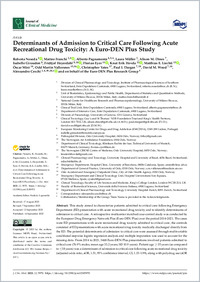Determinants of admission to critical care following acute recreational drug toxicity : a Euro-DEN plus study
- Noseda, Roberta Division of Clinical Pharmacology and Toxicology, Institute of Pharmacological Sciences of Southern Switzerland, Ente Ospedaliero Cantonale, Lugano, Switzerland
- Franchi, Matteo Unit of Biostatistics, Epidemiology and Public Health, Department of Statistics and Quantitative Methods, University of Milano-Bicocca, Italy - National Centre for Healthcare Research and Pharmacoepidemiology, University of Milano-Bicocca, Italy
- Pagnamenta, Alberto Clinical Trial Unit, Ente Ospedaliero Cantonale, Lugano, Switzerland - Department of Intensive Care, Ente Ospedaliero Cantonale, Lugano, Switzerland - Division of Pneumology, University of Geneva, Switzerland
- Müller, Laura Division of Clinical Pharmacology and Toxicology, Institute of Pharmacological Sciences of Southern Switzerland, Ente Ospedaliero Cantonale, Lugano, Switzerland
- Dines, Alison M. Clinical Toxicology, Guy’s and St Thomas’ NHS Foundation Trust and King’s Health Partners, London, UK
- Giraudon, Isabelle European Monitoring Centre for Drugs and Drug Addiction (EMCDDA), Lisbon, Portugal
- Heyerdahl, Fridtjof Prehospital Division, Oslo University Hospital, Norway -The Norwegian Air Ambulance Foundation, Oslo, Norway
- Eyer, Florian Department of Clinical Toxicology, Klinikum Rechts der Isar, Technical University of Munich, Germany
- Hovda, Knut Erik The Norwegian CBRNE Centre of Medicine, Oslo University Hospital, Norway
- Liechti, Matthias E. Clinical Pharmacology and Toxicology, University Hospital and University of Basel, Switzerland
- Miró, Òscar Emergency Department, Hospital Clínic, University of Barcelona, Catalonia, Spain
- Vallersnes, Odd Martin Department of General Practice, University of Oslo, Norway - Oslo Accident and Emergency Outpatient Clinic, City of Oslo Health Agency, Norway
- Yates, Christopher Emergency Department and Clinical Toxicology Unit, Hospital Universitario Son Espases, Mallorca, Spain
- Dargan, Paul I Clinical Toxicology, Guy’s and St Thomas’ NHS Foundation Trust and King’s Health Partners, London, UK - Clinical Toxicology, Faculty of Life Sciences and Medicine, King’s College London, UK
- Wood, David M Clinical Toxicology, Guy’s and St Thomas’ NHS Foundation Trust and King’s Health Partners, London, UK - Clinical Toxicology, Faculty of Life Sciences and Medicine, King’s College London, UK
- Ceschi, Alessandro ORCID Division of Clinical Pharmacology and Toxicology, Institute of Pharmacological Sciences of Southern Switzerland, Ente Ospedaliero Cantonale, Lugano, Switzerland - Clinical Trial Unit, Ente Ospedaliero Cantonale, Lugano, Switzerland - Faculty of Biomedical Sciences, Università della Svizzera italiana, Switzerland - Department of Clinical Pharmacology and Toxicology, University Hospital Zurich, Switzerland
- 2023
Published in:
- Journal of Clinical Medicine. - 2023, vol. 12, no. 18, p. 5970
Recreational drug use
Toxicity
Emergency department presentation
Determinants of critical care admission
Euro-DEN Plus
English
This study aimed to characterize patients admitted to critical care following Emergency Department (ED) presentation with acute recreational drug toxicity and to identify determinants of admission to critical care. A retrospective multicenter matched case-control study was conducted by the European Drug Emergency Network Plus (Euro-DEN Plus) over the period 2014–2021. The cases were ED presentations with acute recreational drug toxicity admitted to critical care, the controls consisted of ED presentations with acute recreational drug toxicity medically discharged directly from the ED. The potential determinants of admission to critical care were assessed through multivariable conditional stepwise logistic regression analysis and multiple imputation was used to account for the missing data. From 2014 to 2021, 3448 Euro-DEN Plus presentations involved patients admitted to critical care (76.9% males; mean age 33.2 years; SD 10.9 years). Patient age ≥35 years (as compared to ≤18 years) was a determinant of admission to critical care following acute recreational drug toxicity (adjusted odds ratio, aOR, 1.51, 95% confidence interval, CI, 1.15–1.99), along with polydrug use (aOR 1.39, 95% CI 1.22–1.59), ethanol co-ingestion (aOR 1.44, 95% CI 1.26–1.64), and the use of gamma-hydroxybutyrate/gamma-butyrolactone (GHB/GBL, aOR 3.08, 95% CI 2.66–3.57). Conversely, lower odds of admission to critical care were associated with the use of cocaine (aOR 0.85, 95% CI 0.74–0.99), cannabis (aOR 0.44, 95% CI 0.37–0.52), heroin (aOR 0.80, 95% CI 0.69–0.93), and amphetamine (aOR 0.65, 95% CI 0.54–0.78), as was the arrival to the ED during the night (8 p.m.–8 a.m., aOR 0.88, 95% CI 0.79–0.98). These findings, which deserve confirmation and further investigation, could contribute to a more complete understanding of the decision-making process underlying the admission to critical care of patients with acute recreational drug toxicity.
- Collections
- Language
-
- English
- Classification
- Medicine
- License
- Open access status
- gold
- Identifiers
-
- DOI 10.3390/jcm12185970
- ARK ark:/12658/srd1331915
- Persistent URL
- https://n2t.net/ark:/12658/srd1331915
Statistics
Document views: 52
File downloads:
- Ceschi_2023_MDPI_jcm_Determinants of Admission: 23
